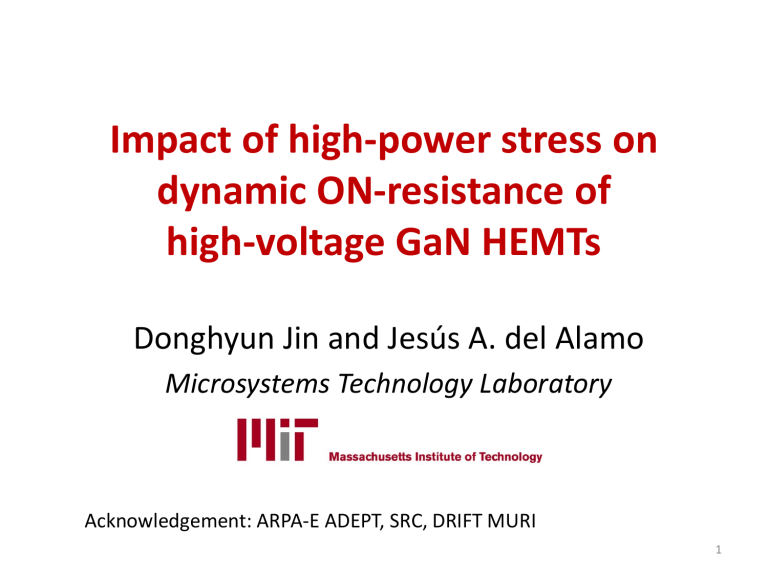RC- 200 slides - Microsystems Technology Laboratories
advertisement

Impact of high-power stress on dynamic ON-resistance of high-voltage GaN HEMTs Donghyun Jin and Jesús A. del Alamo Microsystems Technology Laboratory Acknowledgement: ARPA-E ADEPT, SRC, DRIFT MURI 1 Outline 1. Motivation 2. Dynamic ON-resistance measurement 3. High-power stress experiment 4. Discussion 5. Conclusion 2 Motivation • Dynamic ON-resistance (RON) a.k.a. “current collapse” IDS In OFF-to-ON switching Tirado et al, TED 2007 ION initial i) ION right after OFF-state: RON ↑ ii) Slow recovery of RON VDS 3 Motivation • Dynamic ON-resistance (RON) a.k.a. “current collapse” IDS In OFF-to-ON switching Tirado et al, TED 2007 ION initial i) ION right after OFF-state: RON ↑ ii) Slow recovery of RON VDS ‒ Primary concern in GaN power-switching and RF power-amplifier devices 4 Motivation • Much less understanding ‒ Impact of electrical stress on dynamic RON ‒ Especially, high-power (HP) state in GaN device operation 5 Motivation • Much less understanding ‒ Impact of electrical stress on dynamic RON ‒ Especially, high-power (HP) state in GaN device operation ID < RF-amplifier > ID < Power-switching > Hard-switching RF load line VDS ON OFF VDS 6 Motivation • Much less understanding ‒ Impact of electrical stress on dynamic RON ‒ Especially, high-power (HP) state in GaN device operation Meneghesso et al, TED 2006 7 Motivation • Much less understanding ‒ Impact of electrical stress on dynamic RON ‒ Especially, high-power (HP) state in GaN device operation • Goal Meneghesso et al, TED 2006 ‒ New methodology for dynamic RON measurement ‒ Investigate the impact of high-power stress on dynamic RON 8 Outline 1. Motivation 2. Dynamic ON-resistance measurement 3. High-power stress experiment 4. Discussion 5. Conclusion 9 Dynamic RON measurement • New methodology for RON transient measurement from 200 ns to any arbitrary length of time ‒ Auriga AU4750 pulsed-IV for RON(200 ns ≤ t ≤ 3 ms) + Agilent B1500A SDA for RON(3ms < t ) 10 Dynamic RON measurement • New methodology for RON transient measurement from 200 ns to any arbitrary length of time ‒ Auriga AU4750 pulsed-IV for RON(200 ns ≤ t ≤ 3 ms) + Agilent B1500A SDA for RON(3ms < t ) • Dynamic RON measurement from pulsed-IV ID 1/RON ION @ VGS= 1 V OFF (VGSQ, VDSQ) VDS 11 Dynamic RON measurement • New methodology for RON transient measurement from 200 ns to any arbitrary length of time ‒ Auriga AU4750 pulsed-IV for RON(200 ns ≤ t ≤ 3 ms) + Agilent B1500A SDA for RON(3ms < t ) • Dynamic RON measurement from pulsed-IV VDS ID 1/RON ION @ VGS= 1 V VDSQ Synchronous switching of VGS and VDS OFF (VGSQ, VDSQ) VGS t 1V t VGSQ VDS 12 Dynamic RON measurement • RON(t) from ID(t)-VDS measurements Q(VGSQ= -10 V, VDSQ= 50 V) 0.08 ID [A/mm] 0.06 0.04 0.02 ID(200 ns ≤ t ≤ 3 ms) @ VGS= 1 V, VDS ≤ 1.2 V 0 0 1 2 Time [sec] 3 -3 x 10 13 Dynamic RON measurement • RON(t) from ID(t)-VDS measurements Q(VGSQ= -10 V, VDSQ= 50 V) 0.08 0.08 0.06 0.02 ID [A/mm] ID [A/mm] 0.06 0.04 ID(200 ns ≤ t ≤ 3 ms) @ VGS= 1 V, VDS ≤ 1.2 V 100 μs 10 μs 0.04 200 ns 0.02 1/RON 0 0 ID(t= 1 ms) @ VGS= 1 V 1 2 Time [sec] 0 0 3 -3 x 10 0.4 VDS 0.8 [V] 1.2 ‒ Extract RON transients from 200 ns up to 3 ms in OFF-to-ON 14 Dynamic RON measurement Q(-5 V, 40 V) * Virgin GaN-onSiC HEMT sample 5.5 Pulsed-IV 200 ns ≤ t ≤ 3 ms RON [-mm] 5 4.5 4 RON_DC= 3.5 Ω∙mm 3.5 -7 -6 -5 -4 -3 -2 -1 0 1 2 3 4 10 10 10 10 10 10 10 10 10 10 10 10 Time [sec] 15 Dynamic RON measurement Pulsed-IV OFF(-5 V, 40 V) to ON Semiconductor Device Analyzer 200 ns ≤ t ≤ 3 ms 3 ms ≤ t ≤ 2.8 hr Q(-5 V, 40 V) * Virgin GaN-onSiC HEMT sample 5.5 RON [-mm] 5 4.5 4 RON_DC= 3.5 Ω∙mm 3.5 -7 -6 -5 -4 -3 -2 -1 0 1 2 3 4 10 10 10 10 10 10 10 10 10 10 10 10 Time [sec] 16 Dynamic RON measurement Pulsed-IV OFF(-5 V, 40 V) to ON Semiconductor Device Analyzer 200 ns ≤ t ≤ 3 ms 3 ms ≤ t ≤ 2.8 hr Q(-5 V, 40 V) * Virgin GaN-onSiC HEMT sample 5.5 RON [-mm] 5 4.5 4 RON_DC= 3.5 Ω∙mm 3.5 -7 -6 -5 -4 -3 -2 -1 0 1 2 3 4 10 10 10 10 10 10 10 10 10 10 10 10 Time [sec] • RON transients over 11 decades in time → details in DJin ISPSD 2012 17 Outline 1. Motivation 2. Dynamic ON-resistance measurement 3. High-power stress experiment 4. Discussion 5. Conclusion 18 High-power DC-stress * Constant HP-stress: VDS= 20 V, ID≈0.6 A/mm, P≈12 W/mm tstress= 10, 20, 30, 40 min (4 samples) * tstress= 40 min sample 100 RON 1.1 1 10 IDMAX 0.9 0.8 1 IGOFF [mA/mm] RON/RON(0), IDMAX/IDMAX(0) 1.2 |IGOFF| 0.7 0.6 0.1 0 10 20 30 High power ON-state stress time [min] 40 • Prominent degradation in RON and IDMAX; minor in IGOFF • Dynamic RON measurement after each HP-stress test 19 Dynamic RON transients 12 Transient from OFF (VGSQ= -10 V, VDSQ= 50 V) to ON (VGS= 1 V, VDS ≤ 1.2 V) RON/RON-DC 10 HP-stress time RON_DC increase 10 7% 20 8% 30 11% 40 16% 8 tstress= 40 min 6 4 2 20 10 30 Virgin 0 -7 -6 -5 -4 -3 -2 -1 0 1 2 3 10 10 10 10 10 10 10 10 10 10 10 Time [sec] • Dynamic RON↑ ≥ 10 x RON_DC after 40 min HP-stress - Up to 30 min: minor increases in dynamic RON • In contrast, small RON_DC↑ (16%) - minor permanent (non-transient) degradation • Fast RON recovery in ms range in all cases 20 Time constant spectrum 0.8 40 min 0.6 Amplitude (ai) RON ai e( t / i ) RON i 0.4 0.2 30 20 0 10 -7 10 -6 10 Virgin -5 10 -4 10 -3 10 -2 -1 10 10 [sec] 0 10 1 10 2 10 3 10 • 40 min HP-stress → fast transient with short time constants (μs ≤ τ ≤ ms) ↑ • In contrast, negligible changes in long time constants 21 Dynamic RON at different T * tstress= 40 min sample 12 85 6 105 125 4 150 [-mm] 8 65 ON 45 T= 25 C 40 OFF(-10 V, 50 V) to ON 30 20 R RON/RON-DC 10 50 T↑ 10 0 -7 -6 -5 -4 -3 -2 -1 0 1 2 3 10 10 10 10 10 10 10 10 10 10 10 Time [sec] 2 0 -7 3 2 1 0 -1 -2 -3 -4 -5 -6 10 10 10 10 10 10 10 10 10 10 10 Time [sec] • As T ↑, RON transients substantially accelerated • RON transients → conventional traps 22 Time constant spectrum at different T * tstress= 40 min sample 2.5 Amplitude [A.U.] 2 25 C 45 C 1.5 65 C 85 C 1 105 C 0.5 125 C 150 C 0 -7 -6 -5 -4 -3 -2 -1 0 10 10 10 10 10 10 10 10 [sec] 1 10 2 10 3 10 • Evolution of dominant time constant peaks at different T 23 Arrhenius plot 20 0.75 eV ln(T2τ) [K2s] 0.57 eV EA= 0.87 eV 15 0.53 eV 10 0.45 eV 5 0.31 eV 0 0.23 eV -5 25 30 35 40 1/kT [eV-1] 45 50 55 • Dominant trap energy levels at 0.31, 0.45, 0.53 and 0.57 eV (below EC of AlGaN barrier) • Responsible for dramatic increase in dynamic RON 24 Outline 1. Motivation 2. Dynamic ON-resistance measurement 3. High-power stress experiment 4. Discussion 5. Conclusion 25 Discussion: HP-stress with higher VDS Transient from OFF (-10 V, 50 V) to ON 5 After 3 min HP-stress with VDS= 30 V, P≈ 9 W/mm RON/RON-DC 4 3 After 20 min HP-stress with VDS= 20 V, P≈ 12 W/mm 2 Virgin 1 -6 -5 -4 -3 -2 -1 0 1 2 3 10 10 10 10 10 10 10 10 10 10 Time [sec] • Fast dynamic RON ↑ only in 3 min with lower P-level • Again, very fast RON recovery down to ms range • HP-stress with VDS↑ promotes fast dynamic RON degradation 26 Discussion: Different epi-supplier * Red solid line: same GaN-on-SiC HEMT design processed in the same lot on nominally identical epitaxial wafer from different epi-supplier (denoted by epi-supplier II) 9 Transient from OFF (-5 V, 40 V) to ON R ON [-mm] 8 virgin epi-supplier II 7 6 virgin epi-supplier I 5 4 RON_DC= 4.6 Ω∙mm RON_DC= 3.5 Ω∙mm 3 -7 -6 -5 -4 -3 -2 -1 0 1 2 3 4 10 10 10 10 10 10 10 10 10 10 10 10 Time [sec] • Very different patterns of dynamic RON transient 27 Discussion: HP-stress on epi-supplier II * HP-stress on epi-supplier II device: VDS= 20 V, ID≈ 0.6 A/mm, P≈ 12 W/mm 100 IDMAX 1 10 RON 0.8 IGOFF 0.6 1 0.4 IGOFF [mA/mm] RON/RON(0), IDMAX/IDMAX(0) 1.2 0.1 0.2 0 0.01 0 20 40 60 80 Time [min] 100 120 • No prominent permanent degradation in RON, IDMAX and IGOFF - Large increase of IGOFF recoverable 28 Discussion: Dynamic RON on epi-supplier II 12 OFF(-10 V, 50 V) to ON RON/RON-DC 10 40 min HP-stress on epi-supplier I 8 6 2 hr HP-stress on epi-supplier II 4 2 0 Virgin epi-supplier II -6 -5 -4 -3 -2 -1 0 1 2 3 10 10 10 10 10 10 10 10 10 10 Time [sec] • Minor increase in dynamic RON up to 2 hr HP-stress • Epi-supplier II device more robust than epi-supplier I - RTH(thermal resistance) of epi-supplier II < RTH of epi-supplier I - Better heat dissipation through different buffer design • Epi-supplier II wafer more traps than epi-supplier I 29 Outline 1. Motivation 2. Dynamic ON-resistance measurement 3. High-power stress experiment 4. Discussion 5. Conclusion 30 Conclusion • Developed new dynamic RON measurement methodology • Key findings from HP electrical stress - Large increase in dynamic RON on a short-time scale - Formation of shallow traps most likely inside the AlGaN barrier or at its surface • GaN HEMTs device operation under RF power or hard-switching conditions - Undesirable increase of dynamic RON on a very short time scale 31








